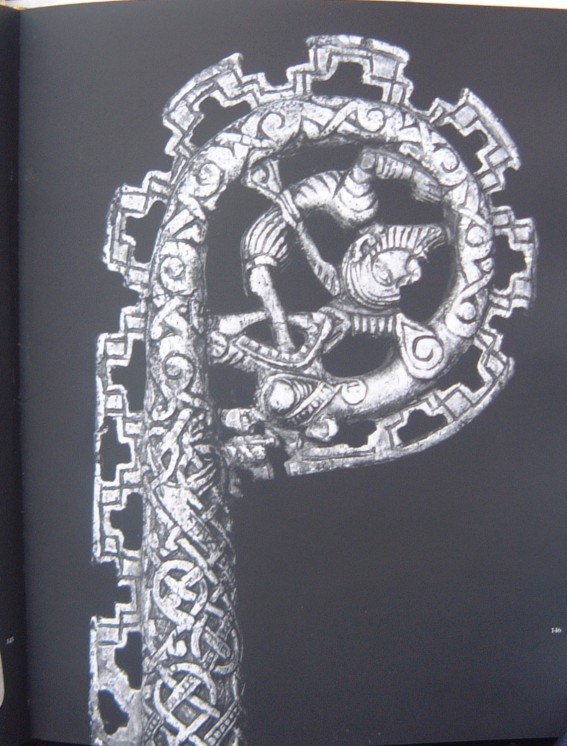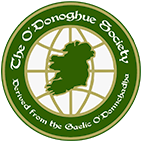
By courtesy of Rod
Aghadoe, in Irish Achadh Dhá Eó (The Field of the Two Yews), which lies on the heights above Loch Léin near Killarney, was the site of residence of O’Donoghue kings in the 12th and 13th centuries.
Aghadoe Cathedral
It is judged that a monastery stood on this site from as early as the 7th century, founded by St Finian Lobhar (Leper). Strong links existed between Aghadoe and Inisfallen (below).

By courtesy of Rod
The Usurper of West Munster and Prince of Loch Léin, Amhlaoibh (Awly) Mór O’Donoghue, expanded the church at Aghadoe Heights in the 12th century in an effort to gain a bishopric in Desmond to counter that at Ardfert, which

By courtesy of Rod
was under the control of O’Connor Kerry, who was allied with Awly’s great enemies, the O’Briens. This cathedral is a fine example of Romanesque design. The likelihood is that the large strongbox tomb visible through the arched doorway in the photo to the right above is that of Awly Mór, who is recorded as being buried in his cathedral after he was killed in battle.
There is no evidence that Aghadoe was ever in fact recognized as a bishopric, but the discovery of the Aghadoe Crosier buried in the cathedral shows how intense Awly Mór’s effort was in attempting to gain a bishopric for south Munster prior to his death. It is possible the Crosier was buried with him.

By courtesy of National Museum
In Victorian times the Aghadoe Crosier was found buried in the remains of the Aghadoe cathedral. The ornamentation along the crest of the crosier matches the surround of the doorway of the cathedral, indicating that it was likely commissioned around the same time, logically by Awly Mór, who had rebuilt and expanded the existing church. The indications are that Awly Mór built Aghadoe Cathedral in order to set up a rival bishopric to the one at Ardfert in North Kerry which was under the aegis of O’Connor Kerry, an ally of the O’Briens.
The crosier is the only extant example of a volute curved style typical of the Romanesque period of the twelfth century. Fashioned from morse (walrus) ivory it is a unique artefact of such material in all Ireland. It is plausible that it was created to also serve as a battle standard and used by Awly Mór during his campaign against Thomond. It is possible that it was buried with him. It is a treasure of Kerry heritage, on exhibition at the National Museum.
The National Museum contends in its audio guide accompanying the display of the artefact that it was possibly made for an O’Moriarty chief, which we find mistaken and contentious. Their logic stems from the belief that there are similarities with the Cross of Cong, commissioned by The O’Connor king of Connacht, with whom O’Moriarty was allied at the time. Compelling evidence suggests this is extremely improbable (see ‘The Usurpers of West Munster’ in the 2012 Kerry Magazine, reprinted in the April 2013 Society Journal and in the 2014 Journal of the Kerry Archaeological and Historical Society) and we have advised the Museum of our concerns. They are unwilling to consider our more logical explanation of its connection to Awly Mór.
Awly Mór’s powerful opposition to Dalcassian ambitions may have included setting himself up as King/Bishop of Aghadoe. He was already identified in the Annals of Inisfallen as ‘Champion of West Munster and High King of Loch Léin’. In any case, his ambitions were cut short when he was killed on the banks of the River Suir in a battle with the O’Briens.

By courtesy of Rod
A few yards from the west end of the cathedral stand the remains of a round tower which probably dates to the early part of the eleventh century. It is most likely that this was a belfry and a place where monastic treasures were placed at times of danger.

By courtesy of Rod
Standing on the heights of Aghadoe provides an exceptional view of the lake and the mountains, no less so today than way back in earlier times.

By courtesyof Rod
Located in Lough Léin, this island can be reached from Ross Castle. A monastery was founded in the seventh century also by St Finian Lobhar and was a centre of learning for a long period thereafter. Brian Boru is said to have studied there. On the island are the remains of the extensive 12th century Augustinian priory and a small 11th -12th century Romanesque church, the doorway of which is shown below. On the top northern jamb is a decorated sandstone capital bearing a mask traditionally believed to represent St Finian.
The Annals of Innisfallen, a major source of early Irish history and now stored in the Bodleian Library in Oxford were at least partly written there. In that century, a period of great anarchy, the monastery was raided by the O’Donoghues. Generally, however, they were patrons of the monks. The island was abandoned during the Cromwellian period. A boat ride on a sunny day to this tranquil place is a must.

By courtesy of Rod

By courtesy of Rod
